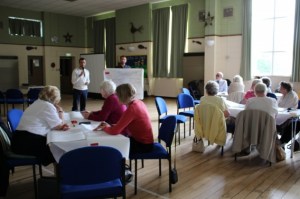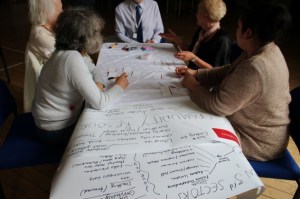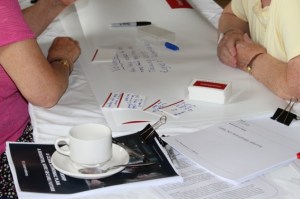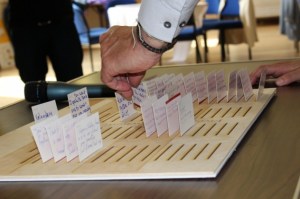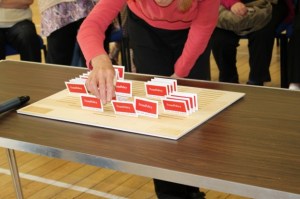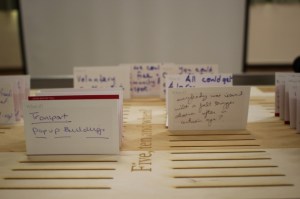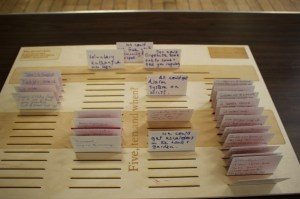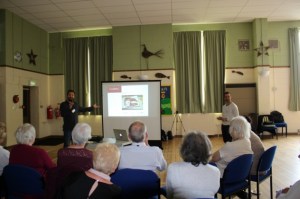Introduction
This ‘conversation’ is a summary of discussions between Sue Ball and Guy Julier in March and April 2015, culminating in their live Q&A at the Lancaster ProtoPublics workshop. This blob is a a redaction of material exchanged between them during that period. The Q&A is structured around two projects that Sue has been engaged in which raise different issues.
Sue Ball is Director of Media and Arts Partnership, Leeds, a public art consultancy that doesn’t do ‘landmark sculptures’ or public artist community engagement programmes. Rather it works closer to complex, sometimes design-led, urban regeneration processes. She was Director of Pavilion in Leeds 1996-2000 and has worked on cultural strategies for engaging citizens in Rochdale and Oldham and with town teams in Scunthorpe and North Allerton. Sue developed a body of work to support interdisciplinary learning, including cross disciplinary peer review and action research, in the ‘making of place’ (2009-10), and to explore ‘the act of listening and our sensory relationships with the city’ (2010-12). More generally, she has worked between the development sector, local government policy, creative practices and academia (though she has never worked in academia).
Sue and Guy Julier worked together as directors of Leeds Love It Share It, 2008-10, a registered Community Interest Company that continues to operate as an open forum for ideas, debate and action in Leeds, aiming to create new visions for how Leeds could be in the future through research into community skills, social networks and the use of local assets.
Banging Heads Together: LLISI
GJ: In Leeds Love It Share It (LLISI) there were seven of us as company directors: ourselves, Paul Chatterton and Rachel Unsworth from the School of Geography at the University of Leeds, the architect Irena Bauman, Katie Hill from Design at Leeds Metropolitan University and Andy Goldring who is CEO of the Permaculture Association. We were motivated by a critique economic and cultural direction of Leeds and its leadership and the challenges of the triple crunch of climate change, global economic crisis from 2005 and Peak Oil.

Early meeting of Leeds Live It Share It, Community Interest Company
We went very quickly from being about manifestos and ideas to actually getting involved in a community-based, publicly funded project. Sue, you raised nearly £100k for it from the then Regional Development Agency, Yorkshire Forward (YF), and the Local Entreprise Growth Initiative (LEGI). I think there were a number of challenges:
- Interfacing between diverse interests/stakeholders/organisations such as YF, LEGI, LCC, neighbourhood, interest groups, regeneration and health arms length organisations while carrying forward an explicit political agenda that was critical of neoliberal status quo held by dominant power interests in the city;
- Learning to work cooperatively in a cross-sector team with different expectations of research practices and outcomes.
A number of other questions arise here. Was it knowledge-focused or were we looking at producing something more tangible? And if it was knowledge-focused, what were some of the conditions that facilitated this? How did we construct these conditions?
SB: We came together informally to develop interdisciplinary praxis as an independent think-tank, to forge a new set of alliances to challenge regeneration planning and policy orthodoxies in Leeds City Council, and to create an open learning environment through practical engagement that offered up our collective practice and processes for broad external review and critical peer appraisal. Some of this was published as a paper in City Journal and as a extended working ‘toolkit’ document (2011).
Due to my previous interest in structuring open reflexive interdisciplinary learning, there’s couple of things that I brought to the table that facilitated knowledge generation I feel.
In terms of the policy context, political leverage and sector buy-in (whole systems appraisal), you mentioned my producer role in raising funding. As important it was to secure buy-in from mainstream commissioners of regeneration services such as Leeds City Council and the Regional Development Agency, in a way that was participative and permissive. A positive attribute of the RDA funding was that there were no specific outcomes required, only a report. The offer from our side was to include them in the process of the research and to allow them to interrogate it as an embedded participant, which offered reciprocal benefits. A further merit of their investment was their badging of the scheme and the honorific value of association which prompted higher status policy-related conversation at city and regional level in response to on-the-ground community-facilitated regeneration in East Leeds.

Mapping of Richmond Hill assets
We initially structured the 12 month research programme that included review and appraisal days. These were held quarterly and were programmed by the team to allow thinking and work in progress to be presented and debated. These sessions brought policy makers and service commissioners together with member of the Richmond Hill community, activists and academics within a broad constituency of stakeholders to consider how land, property, skills and network capacities at a local level could be appreciatively re appraised to generate forms of sustainable resources and assets. These sessions enabled the LLISI team to reflect on research methodologies, visual communication tools, and learning derived from field studies, and to finetune delivery according to emergent opportunities. This structure also built trust with local people and councillors who initially viewed LLISI as yet another set of professionals landing on the community.
Summary of Issues Arising from LLISI
- how to declare the intention of the broker (issues of neutrality?)
- that funding and agendas drive outcomes/outputs (hard negotiations to secure permissive flexible funding)
- should deliver locally, act locally, but understand policy and include policy makers (whole system appraisal)
- bring different stakeholders together into structured dialogue to unlock their own internal dynamics and resources (infrastructure development)
- visual communication is key – how to develop well researched (often visual) data and information in a form that works for the end-user as advocacy/lobbying material, or to articulate systems and what’s happening now and next steps
- need to challenge commissioners and funders to re engineer funding programmes that recognize changing conditions – bring them in as co-producers
- co-production elements stitched in were very beneficial – how to structure reflective learning environment
- connected community practice with academic input, but at times this did feel awkward
- important learning and formative experience for all LLISI members.
Dodging and weaving: Warwick Bar
GJ: I’m a bit of a fan of dodging and weaving as a research method. This means that you adopt an open and flexible approach to developing a practice and accounting for it, producing or prototyping innovations along the way.
You’ve been working with developer ISIS Waterside Regeneration on their Warwick Bar scheme in Digbeth, Birmingham since 2010 where I think a lot of this attitude has been employed in your way of practising. Can you tell us a bit more about this project?

SB: I’ve been working with developers for about 10 years now and in particular Isis Waterside Regeneration and developer Mike Finkill. Warwick Bar is 2.8 hectares, with 43,000 sq ft of lettable space, and about 15 mins walk from New Street station on Birmingham in Digbeth, post industrial & heavy manufacturing base. In 2010 there was only 20% of the site occupied. I was invited to work with Mike and I requested that we should start by working closely with the commercial agent Colliers International. I organized joint visits to Glasgow Spiers Lock and other sites where there was a different more proactive relationship with tenants. We developed a number of ways of re-activiting the space such as small physical interventions over time, responsive relationship with tenants and Open Doors events to wide constituency of arts, third sector, community people to welcome ideas for usage.
The commercial agents default setting is to focus on forcing up the commercial value of property. But we developed a Meanwhile Licensed Use of 45 days to enable R&D activities, which levered a 6 month business rates ‘holiday’ on each industrial units (3 months on offices). I took the units under license through Art in Unusual Spaces CIC, of which I’m a Director, and the savings were transferred to me which I used to commission artists and cultural activity. Up to last year, I leased units under 45 day license and through this internal economy, commissioned a wide range of arts and cultural agencies to use the units and public spaces such as Companis, Cathy Wade, Homes for Waifs and Strays, Flatpack Cinema etc. I also wrote a Meanwhile Use Policy, which was adopted by the Client, that all empty units should be offered up through the website for meanwhile use.
GJ: This sounds a bit less experimental than the LLISI work?
SB: I think working closely with developers certainly was less ‘activist’ in its roots, but within the project there were several gaps and openings to develop new processes and relationships. I’d summarize these as follows.
- Licence Innovation Another innovation in licensing was to develop ‘nomadic leases’ which offered a 10 year licence to agencies that wanted land for growing and cultivation, without this lease security, they can’t fundraise. We might have to move within the site if development take place. For instance Edible Eastside.
- Meanwhile Use as a Strategy I’m critical of meanwhile use, short-termism and hidden economies of the pop-up. This license and use demonstrates an alternative and a win-win situation for both the client and cultural economy. The site was only 20% occupied four years ago – now almost 100% with no hard marketing needed – mostly word-of-mouth testimonials.
- Judicious Interventions Starting out, I went out to connect with the Birmingham cultural sector and met with Ikon Gallery who were looking for a mooring for their 3 year arts/youth programme Slow Boat. We jointly developed a mooring space that in turn created a more amenable public realm. The public realm and canalside locale was used for summer and winter events drawing in audiences from Digbeth and the city. We have developed a very collegiate culture of co-operation onsite and this has been achieved in part by responsive intervention and also by encouraging all tenants to open their doors and programme for the public events in the summer.
- Dense Networks Warwick Bar/Minerva Works is now a densely interconnected complex of design, architecture, arts, fabricators & printers (commercial and not-for-profit) with Clifton Steel steel sheet producer as its anchor tenant. Key arts agencies for Brum include Vivid Project (digital media/film); Grand Union (VA), Styrx (VA), Homes for Waifs and Strays (Live Art), Centrala (Polish cultural centre) who now play host to national festivals such as Fierce Live Art; Flatpack Cinema and Supersonic experimental music. This is all organized internally and supported by Colliers as site managers.
- Independent Review and Appraisal With the client, I commissioned an independent report in autumn 2014 by Dr Rachael Unsworth at the University of Leeds on the characteristics of the regeneration of Warwick Bar which were framed up as ‘slow architecture’ in that we are creating a structure or ensemble of structures gradually and organically with regard to sustainability criteria, as opposed to rapid construction to achieve short-term goals. We define structures as systems, governance, relationships and value here.
- Policy and Future Proofing We are using the report now as a provocation to the city and Digbeth in the face of HS2 major investment and being tactical about the future, we are supporting the setup of the Digbeth Business Investment District in ways to ensure the representation of micro and small businesses that predominate the manufacture and cultural sectors in the area.
- Linking to HEIs Now the 43,000 square feet of lettable space is almost fully occupied, I am building on what is there by developing a partnership with Birmingham City University’s Cross Innovation Unit to support the emergent intra-trading and collaboration that happens onsite. Again it is the diversity of companies, commercial and not-for-profit, around manufacture, fabrication and creative/digital agglomeration, with the collegiate culture, that underpins emergent trading/sharing activity.
Issues arising
- Creating and building densely Interconnected networks (infrastructure) which self generate and have their own sense of future ambition (beyond my/our involvement)
- Creating permissive and responsive governance and policy that is ‘porous’
- How to get it right for now but plan for the future and avoid short-termism
- How to find the right balance between creativity of emergence and stability of design
- How to prevent a ‘toolkit approach’ when processes are scaled up or transferred.
MAAP online portfolio www.maap.org.uk



